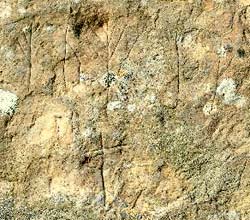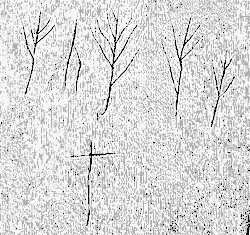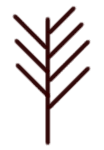
 |
 |
| Home |
| About Orkney |
| History |
| Tradition |
| Folklore |
| Placenames |
| Images |
| Downloads |
| About the Site |
| Contact |
| Links |
| Search Site |
| Awards |
| Runes in Orkney | |
The twig runes of Brodgar Carved into the broken stump of one of the stones of the Ring o' Brodgar in Stenness, is a group of Norse runes. The runes are found on the third standing stone, counting clockwise from the ring's north-western entrance causeway. The style of the runes used on the Brodgar stone is known as twig runes - so called because of their twig-like appearance. These twig runes are cryptographic and are deciphered by counting the branches on either side of the rune (right then left) and referring to a corresponding letter from the chart. The Brodgar runes were found in 1907, during an operation to erect a fallen stone. When the stone was lifted, the runic script was discovered on the side that had been lying on the ground. But attempting to translate the Brodgar runes using the normal method of decrypting twig runes yields nothing - either NROUN or possible NUON. Shortly after their discovery, the scholar Magnus Olson read the runes from right to left. Ignoring a faint "branch" on the furthest right rune, he stated the runes read "biorn", representing the personal name "Bjorn". Olsen's theory is not entirely accepted, however.
In his paper on Orkney's runes, Michael Barnes questioned the "Bjorn" translation. Even if we could accept Olsen's two assumptions about the inscription, he wrote, there is still a problem with the second rune - the non-twig rune representing "u" or possible "r". In short, although there have been theories proposed about the origin and translation of the Brodgar twig runes, we can not say with any certainty that they can be translated. The lost Brodgar inscription
The 'Bjorn' runes were not the only runes unearthed at Brogar in the early years of the 20th century - although the second example has since been lost. The second Brodgar runic inscription was found in 1908, carved into a loose stone discovered in the south-western section of the stone circle. The inscription showed a solitary twig rune, with a cross underneath, exactly like the other Brodgar runes. But because it was a loose stone, the find has since been lost. Fortunately, however, the inscription was documented before the stone was lost and showed a (3/4) rune that is translated as "O". Once again Magnus Olson suggested this represented the initial of a personal name such as "Olaf" - echoing his "Bjorn" interpretation for the standing stone rune. Michael Barnes, however, points out that the missing rune is simply a mirror image of the second twig rune on the "Bjorn" inscription - even incorporating the cross beneath the rune. Was it, he suggested, merely a later copy scratched into a stone by a visitor to the Ring o' Brodgar? A copy that was later discarded by the creator? |
More examples of twig runes are found within the main chamber of Maeshowe. |



